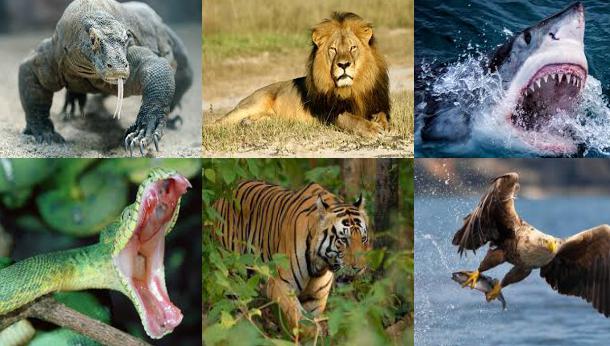Predators: Killing for a Living
Predators: Killing for a Living is a BBC nature documentary series hosted by Anthony Hopkins and John Shrapnel, exploring how animals have developed their own ways to capture prey to survive in nature. In the animal kingdom, it's kill or be killed on a daily basis, as creatures struggle to survive and vicious cycle of life and death is an everyday event in the wild. This documentary series chronicles the different yet lethal techniques used in this dance of death, from animals that work in well-organized gangs to lone killers that capture prey using camouflage and the element of surprise.
 |
Episode 01 - Dining Alone
Lone predators have developed an amazing range of means to survival. The speed of cheetah, snake venom and the ability of leopard to lie in ambush are examples of refined instincts needed when hunting alone.
Episode 02 - Dressing for Dinner
Predators use large numbers of clever ways to trick each other, such as misrepresentation, nets and traps.
Episode 03 - Company of Killers
Group hunting guarantees catch, and living in community is favourable basis for defense: lions, hyenas and wild dogs in packs.
Episode 04 - Ocean Peril
All sea creatures have developed their own ways to kill and to avoid being killed. Beside visual, hearing and smelling sense there are also specific ways for species.
Episode 05 - Flight to the Death
Predatory birds are the most powerful and skilled beasts in the sky. Each species has its own way to obtain meals.
Episode 06 - The Killing Queen
Lion is arguably the most important predator in the African savannah. But among them the female lion is the one who works as a killing machine.
Episode 07 - Rivers of Life, Rivers of Death
The river is the focal point of all life. But there where is life is also dying, and beneath the river surface the battle between preys and predators continues all the time.
Episode 08 - Hunters of the Underworld
Poisonous scorpions, spiders with big claws, myriapods, armored insects, ... Here are just some of the crawling creatures that stalk prey in the shadows beneath and around our feet.
Episode 09 - Killers of the Dark
Nocturnal creatures are having an arms race. Their weapons are not offensive or defensive, but an espionage equipment.
Episode 10 - Sharks! Sharks!
The lives of sharks both as predators and prey. Amount of shark species is enormous, and they are amazingly different in shapes, sizes, and each species of sharks have their own way to live and work.
Episode 11 - Murder in the Family
A look at the animals that kill representatives of their own species. As the animal grows the battle continues: food, power, possibility to copulate. Any of these fights may end in death.
Episode 12 - Cold-Blooded Killers
Tyrannosaurus rex, "Terrible Lizard King", lives in our imagination as the greatest beast ever to have walked on Earth's surface. Maybe it's good that T. rex is extinct, but many still existing animals have ancestors who passed the same terrain with this monstrous predator.
| Related Links |
| Animal Weapons What happens behind the scenes at the Museum? Why is it important to preserve the 70 million specimens in the collections? |
| Life on Earth: The Hunters and Hunted This episode surveys mammal herbivores and their predators. The herbivores began to populate the forests when the dinosaurs disappeared, and many took to gathering food at night. |
| The Ecological Function of Apex Predators A food web is a network of linked consumer-prey interactions. The apex predators in food webs are typically large animals that feed on other species but have no predators themselves. |
| Dynasties This is a five-part BBC documentary series narrated by David Attenborough, looking at five extraordinary animals, fighting for their own survival and for the future of their dynasties. |
| The Trials of Life: A Natural History of Behaviour The series consists of twelve 50-minute episodes, each of which features a different aspect of the journey through life, from birth to adulthood and continuation of the species through reproduction. |